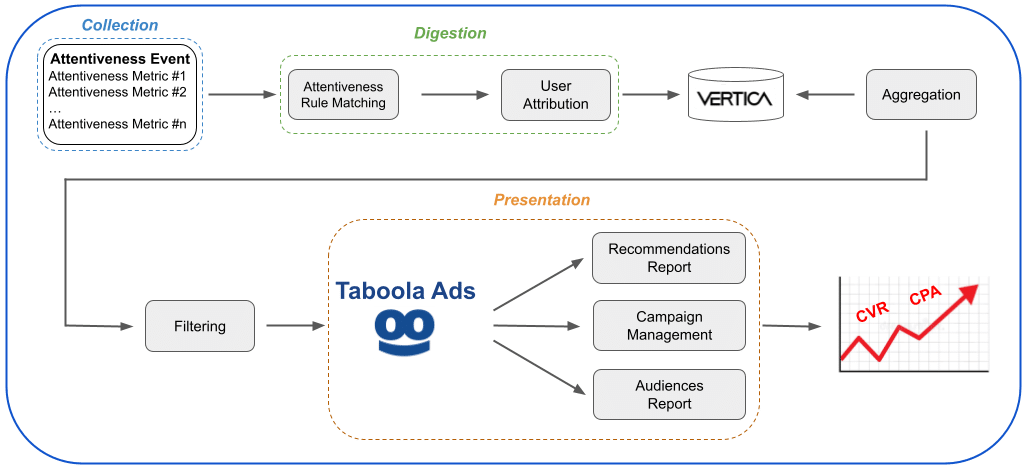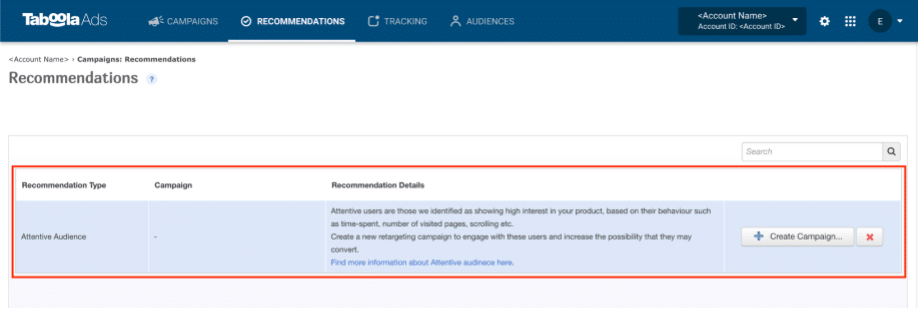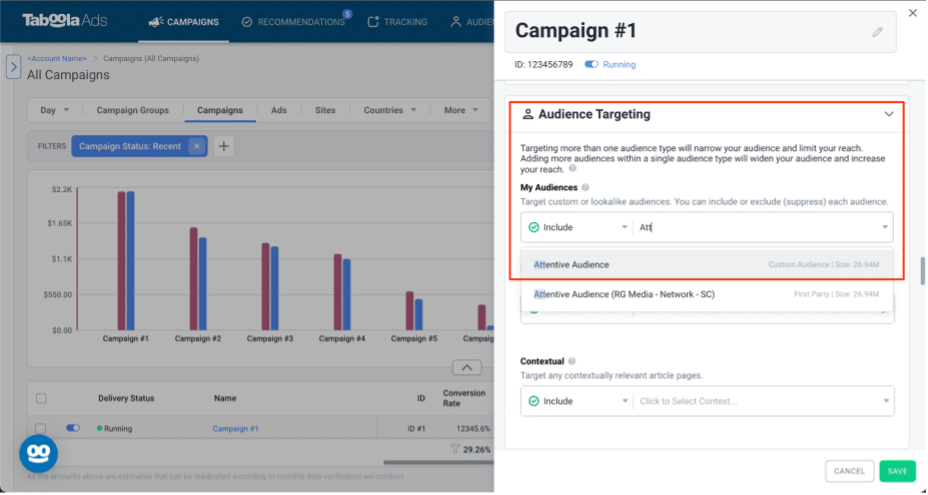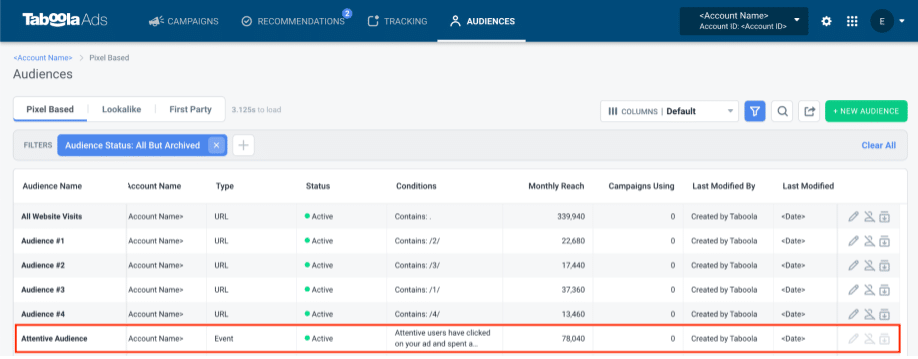Two metrics advertisers use to measure that are Cost Per Action (CPA) and Conversion Rate (CVR). A high CPA means they’re spending too much for each audience action and a low CVR means they’re not getting a good return on that investment (ROI). We wanted to see if there was a way Taboola could enhance our solution to make it easier for advertisers to lower their CPA or increase their CVR.
That’s why we created the Attentive Audience program.
It’s a new way that Taboola collects, aggregates, and filters audience data to be more meaningful for advertisers looking to improve these two metrics. Keep reading to discover how we developed the program and rolled it out to select advertisers.
The basics of the Attentive Audiences project
Before we get into the details of the project, let’s go over some relevant definitions and concepts.
Attentiveness Metrics: These metrics measure user attention on the advertiser’s website and predict the user’s likelihood of converting on the advertiser’s website. They’re based on signals like time on site and the number of returning visits, etc..
Attentiveness Event: A request from an advertiser’s website to Taboola’s servers containing a distinct name and attentiveness metrics value.
Conversion and Attentiveness Conversion: In Taboola, conversions are based on specific rules and aligned with the advertiser’s business goals. Each type is unique to each advertiser and are set in the conversion and attentiveness conversion rules, respectively.
Attentiveness Rule: This rule is a unique set of conditions based on the attentiveness metrics set for each advertiser. For example, time on site > 30 seconds and number of returning visits > 2 visits
Conversion Rate (CVR): The total number of users who converted divided by the total number of visitors to an advertiser’s website.
Cost Per Action (CPA): The amount of money an advertiser pays for a single conversion. It’s calculated by dividing the total budget spent by the number of conversions.
Our goal for the project
Our business goal for this project was to increase CVR or reduce CPA, as they are both dependent on the total number of conversions. We planned to do it by offering advertisers a unique retargeting group of attentive users who have a higher chance of converting on their website.
How we implemented the project
To create a unique group of attentive users for each advertiser, we set up a dedicated workflow to handle the data collection, digestions, aggregation, filtering, and presentation.

Project Architecture
1. Collection
We used the Taboola Pixel to collect the users’ required session-related attentiveness metrics when they visited an advertiser site. The data was then sent to the Taboola servers by an attentiveness event at a defined time interval.
2. Digestion
Attentiveness events go through two filters on the Taboola server-side: rule matching and user attribution. These filters are used to find only events that matched the advertiser’s attentiveness rule by users that reached the advertiser’s website through one of Taboola’s publisher partners. All other events are ignored for this workflow.
3. Aggregation
The attentiveness conversions are then written to a Vertica cluster for further aggregation. The data aggregation is performed offline daily and looks for two types of data per advertiser:
- Basic data, like the number of conversions, attentiveness conversions, clicks, and so on.
- Performance metrics, like attentiveness conversions that preceded other non-attentiveness conversions (precision) and for the percentage of non-attentiveness conversions that came after attentiveness conversions (recall).
4. Filtering
By filtering the aggregated data, we’re looking to find which advertisers would benefit from targeting attentive audiences. More specifically, we’re looking for audiences that would have a high positive impact on the advertiser’s campaign goals. We perform several basic and performance data verifications, including: verifying the thresholds for the number of attentiveness conversions and the percentage of attentiveness conversions and the percentage of attentiveness conversion precision and recall.
The most important filter happens at the end of this stage by verifying multiple-day results of the earlier filters to determine the attentive audience viability group for each advertiser. If the data passes this filter, Taboola offers the Attentive Audience enhancement to the advertiser.
5. Presentation
Advertisers that are offered Attentive Audiences find it in three areas of the Taboola Ads campaign management platform.
As a recommendation
It will appear as an option for the advertiser on the Recommendation screen.

When setting up a campaign
Attentive Audiences is a targeting option when setting up a new campaign:

When viewing their audience types
It appears as an audience type on the Audiences screen.

The Attentive Audience project results
We currently have thousands of advertisers using Attentive Audience, and they’ve enjoyed significant success. Advertisers enjoyed a median CVR increase of 87% and a median CPA decrease of 34%.
Here are just a few examples of advertisers who enjoyed great success with attentive audiences:
- VAHA doubled their CVR across all channels and increased site visit engagement by 338%.
- Pionier Developers increased their CVR by nearly 44% and decreased their cost per lead by 35%.
- Look After My Bills lowered their CPA by 60% and gained 10,000 new memberships in nine months.
- The Motley Fool Canada decreased CPA by 11% and generated an average of 25,000 leads per quarter.
We also noticed two main drawbacks to the Attentive Audience project: only a few advertisers qualified for it, and we couldn’t target audiences outside of advertiser site visitors.
Areas of improvement for the Attentive Audience project
The project or feature is only available to a small portion of Taboola advertisers in its current form. That means most of our advertisers don’t have access to the feature and cannot increase their CVR or lower their CPA through Attentive Audience. We’ll be looking at ways we can offer it to more advertisers, but for now, it’s only available to a select few.
Secondly, the project only looks at an advertiser’s website visitors, but Taboola offers many more audiences than that. We need to find a way to discover the users who have a high chance of converting but haven’t necessarily visited an advertiser’s site first.
As a first attempt, we are pleased with the Attentive Audiences project. It was a good exercise for our engineering teams to learn how to help advertisers in a specific way and reach more of their business goals. We were able to find, aggregate, filter, and present relevant targeted audiences to advertisers so they could hit more of their business objectives, like increasing conversions, lowering advertising costs, and growing revenue.
We look forward to enhancing the project in the future to scale it up to the level where we can offer it to all our advertisers.
Advertiser success is one of Taboola’s main goals as we want to help our advertisers gain the most out of their investment with us.